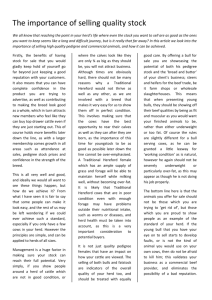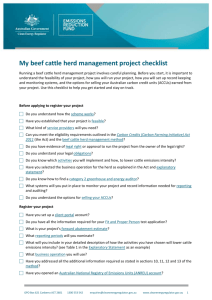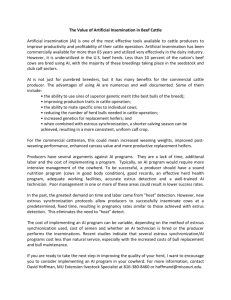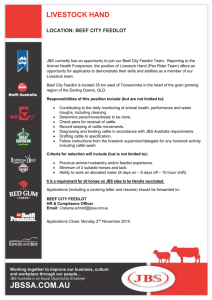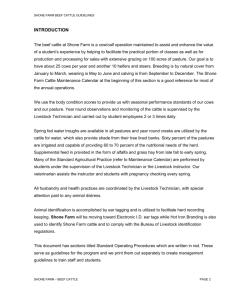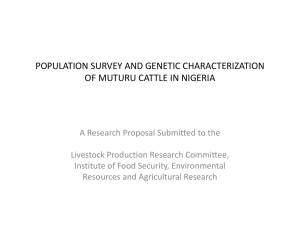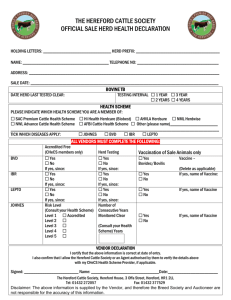Unit 1: Overview of the livestock & Poultry industries
advertisement
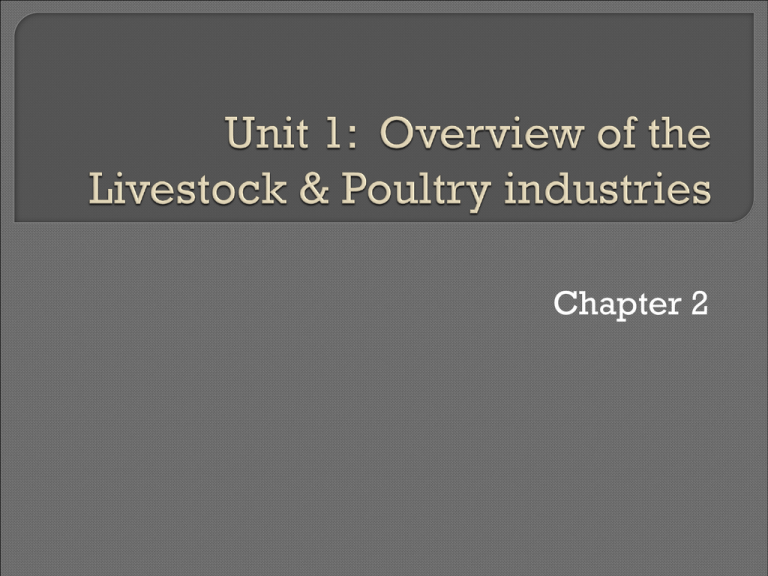
Chapter 2 Role & impact of U.S. livestock industry International trade influences on animal agriculture industry Overviews of animal livestock industries Historically – most farms very diversified • How so? • How is it different today? U.S. – 283 million consumers – plus demand in the international market = high output demand from U.S. livestock producers Cash receipts from livestock products comprise 51% of all agricultural sales 22 states have cash receipts >$2b Refer to table 2.3 Notice animal agriculture is positive – others are negative Much is driven by cattle hides, beef, fat/tallow, dairy Volatility in the market has had significant impact on farm-gate profits • Not only U.S. supply/demand dynamics…but international • If you are to be profitable long-term – know the averages for your commodity, and understand how to ride the highs/lows Global Perspective • Cattle domesticated in Asia & Europe • Provide: food, fiber, fuel, power • What is our main use of cattle? How about a developing country? • 30 yr trend increasing cattle numbers Greater demand for beef Increased export demand • U.S. - largest producer • India – most cattle • Uruguay & Argentina – highest per capita consumption U.S. • Comprised of producing, processing, consuming segments • Currently takes ~30m less head of cattle to produce same amount of beef produced in the 70’s Carcass wt increased Increased cattle fed/feedlot Market age decreased Cross-breeding Imported cattle to finish in the U.S. Cattle Production • Three phases: Cow/calf – birth to 6-10 mos. Stocker-yearling – 600-850 lbs. Feedlot – 850+ lbs. • Average market range – 15-24 mos. • Cow-Calf Production 33m head throughout country – most concentrated in high forage availability areas 60% of operations have <50 cows 70% of cattle inventory located on farms >100 cows Commercial and seed-stock producers • Stocker-Yearling Production Grown for feedlot finishing programs Can take advantage of a variety of feeding situations that might be cheaper, or even not available all year • Feedlot Production Most fed harvested feeds (only 10-15% are finished on pasture) Typically located near abundance of feed Global Perspective • India leading country in total head (38m) • U.S. highest total fluid milk production • Butter, cheese, and dried milk are highest total exports U.S. • Average U.S. dairy ~ 100 cows, farm 2-300 acres, raise own forage, market through coops • Average producer markets ~1.5 m lbs milk/yr, value ~$200,000 • Average total capital investment $500,000 70% of cows located on large operations (>100 cows)…2001 data U.S. herd ~9m head – 1/3 of herd total 50 yrs ago Average production 19,951 lbs/cow Global Perspective • Domestication ~5,000 yrs ago • Purposes? • U.S. herd total ~5m (4th in the world), world herd ~55m U.S. Perspective • Rapid decline in the U.S. population coincided with development of vehicles and power equipment • 3.5% of consumer expenditures for recreation spent in the horse industry • Horse owners tend to be upper-middle class and well-educated • Annual costs for maintaining a horse ranges from $1000 to $15000 per head Average costs: Boarding - $150-$250/mo Training & riding lessons - $300-$600/mo and $20-$50/hr Farrier service - $50-75 • Herd numbers increased steadily in 60’s and 70’s, declined rapidly in the 80’s Current herd population on the rise again Global Perspective • China has largest herd, U.S. leads in total production, Netherlands leader in total per capita consumption • Fastest growing source of meat for consumption U.S. Perspective • Income exceeds $21b/yr • Modernized poultry production began in the 1950’s • Integration became implemented heavily from 1955-75 • Most poultry now raised on contract basis • Broiler production increased from 3.7m lbs in 1960 to 36.5m lbs in 1996 • Dramatic increases in egg production 1880 – 100 eggs/hen/yr 1950 – 175 eggs/hen/yr 1986 – 250 eggs/hen/yr 1997 – 255 eggs/hen/yr • Majority of egg production from large, commercial units • Turkey production has evolved from a primarily seasonal industry to year-round industry • Export market became lucrative in 80’s and 90’s Global Perspective • Originated in Europe and Northern Asia • Often graze different species of plants than cattle, and can produce on lesser quality feeds • World population nearly 1.1b in 2002 – highest on record U.S. Perspective • Population declined from 56m in 1942 to 6.5m in 2006 • Mortality rates can be high Global Perspective • 50% of world population in China Leader in numbers and production • U.S. herd is more productive U.S. Perspective • 2005 cash receipts ~$12b • Majority of production located near the corn belt Why? • Iowa ~25% of U.S. production • Number of farms greatly declined in last 20 yrs • Increasing pressure from environmental and welfare concerns • We’ll cover the various types of production operations in future units


